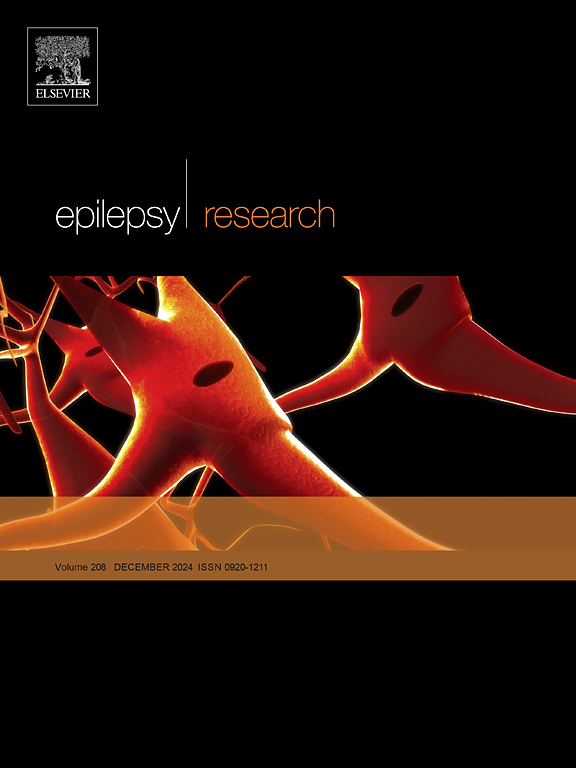Docosahexaenoic acid provides a protective effect in amygdala-kindled rats by activating peroxisome proliferator-activated receptor α
IF 2
4区 医学
Q3 CLINICAL NEUROLOGY
引用次数: 0
Abstract
Introduction
Docosahexaenoic acid (DHA) is a bioactive fatty acid with safe and acceptable anti-seizure activity in clinical and animal studies. Temporal lobe epilepsy (TLE) is the most common form of epilepsy in adults, with a high rate of drug resistance. The peroxisome proliferator-activated receptor α (PPARα) is expressed in the brain and plays a significant role in oxidative stress, energy homeostasis, and mitochondrial fatty acid metabolism. We aimed to evaluate the acute effect of DHA on the amygdala-kindled seizures and the role of PPARα in the DHA effect.
Methods
Male rats were kindled by repetitive daily electrical stimulation of the amygdala through a stimulating-recording electrode. DHA 1 mM (alone, or along with the PPARα antagonist GW6471, 2 and/or 4 μg/rat) was injected into the lateral cerebral ventricle of the kindled rats. The amygdala-kindled seizures were evoked 15 and 30 min after drug administration. The duration of after-discharges (ADD), generalized seizure behavior (S5D), and total seizure behavior (SD) were recorded.
Results
DHA significantly decreased ADD (p < 0.05), S5D (p < 0.05), SD (p < 0.05), and incidence of S5 (p < 0.05). GW6471 2 μg/rat did not change seizure parameters but at 4 μg/rat significantly increased ADD (p < 0.001). GW6471 2 μg/rat diminished the anticonvulsant effect of DHA.
Conclusion
Acute administration of DHA inhibits amygdala-kindled seizures by activating PPARα. Although PPARα is a nuclear receptor, it partly mediates the acute anti-seizure effect of DHA by rapid non-genomic changes in cellular function. This finding reveals another characteristic of the remarkable omega-3 fatty acid, DHA.

二十二碳六烯酸通过激活过氧化物酶体增殖物激活受体α对杏仁核点燃大鼠具有保护作用
二十二碳六烯酸(DHA)是一种生物活性脂肪酸,在临床和动物研究中具有安全和可接受的抗癫痫活性。颞叶癫痫(TLE)是成人中最常见的癫痫形式,具有很高的耐药率。过氧化物酶体增殖物激活受体α (PPARα)在大脑中表达,在氧化应激、能量稳态和线粒体脂肪酸代谢中起重要作用。我们旨在评估DHA对杏仁核点燃癫痫发作的急性作用以及PPARα在DHA作用中的作用。方法通过刺激记录电极对大鼠的杏仁核进行每日重复的电刺激。将DHA 1 mM(单独或与PPARα拮抗剂GW6471、2和/或4 μg/大鼠)注射到点燃大鼠的侧脑室。给药后15和30 min引起杏仁核点燃癫痫发作。记录出院后持续时间(ADD)、全身癫痫发作行为(S5D)和总癫痫发作行为(SD)。结果dha显著降低了ADD (p <; 0.05)、S5D (p <; 0.05)、SD (p <; 0.05)和S5发生率(p <; 0.05)。GW6471 2 μg/大鼠未改变癫痫发作参数,但4 μg/大鼠显著增加ADD (p <; 0.001)。GW6471 2 μg/大鼠降低DHA的抗惊厥作用。结论DHA急性给药可通过激活PPARα抑制杏仁核点燃性癫痫发作。虽然PPARα是一种核受体,但它通过细胞功能的快速非基因组变化部分介导DHA的急性抗癫痫作用。这一发现揭示了ω -3脂肪酸DHA的另一个特点。
本文章由计算机程序翻译,如有差异,请以英文原文为准。
求助全文
约1分钟内获得全文
求助全文
来源期刊

Epilepsy Research
医学-临床神经学
CiteScore
0.10
自引率
4.50%
发文量
143
审稿时长
62 days
期刊介绍:
Epilepsy Research provides for publication of high quality articles in both basic and clinical epilepsy research, with a special emphasis on translational research that ultimately relates to epilepsy as a human condition. The journal is intended to provide a forum for reporting the best and most rigorous epilepsy research from all disciplines ranging from biophysics and molecular biology to epidemiological and psychosocial research. As such the journal will publish original papers relevant to epilepsy from any scientific discipline and also studies of a multidisciplinary nature. Clinical and experimental research papers adopting fresh conceptual approaches to the study of epilepsy and its treatment are encouraged. The overriding criteria for publication are novelty, significant clinical or experimental relevance, and interest to a multidisciplinary audience in the broad arena of epilepsy. Review articles focused on any topic of epilepsy research will also be considered, but only if they present an exceptionally clear synthesis of current knowledge and future directions of a research area, based on a critical assessment of the available data or on hypotheses that are likely to stimulate more critical thinking and further advances in an area of epilepsy research.
 求助内容:
求助内容: 应助结果提醒方式:
应助结果提醒方式:


